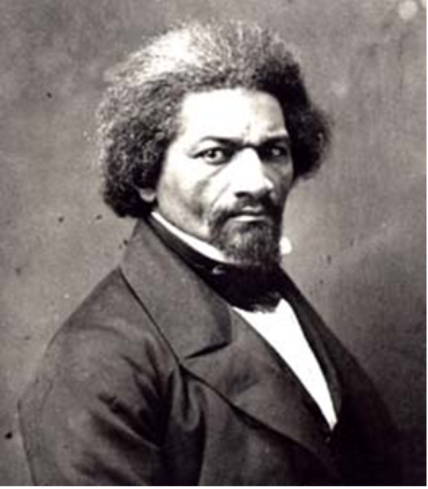
Whenever the great abolitionist leader Frederick Douglass and the State of Indiana are mentioned together, it is usually in reference to the mobbing of Douglass at Pendleton. Interestingly, were it not for a typographical error, a Westfield man would be included in the historic accounts as one of the defenders of Douglass. However, even aside from his brush with history, Micajah C. White and his connection to the anti-slavery movement make for an inspiring story.
The story of Douglass’ assault is well known. In 1843, he was on a speaking tour of the midwestern states. He and several members of the New England Anti-Slavery Society were trying to rouse abolitionist support in what was then considered the Western U.S. Regrettably, they were met with hostility and threats. On September 16, they were to speak at a church meeting in Pendleton. As they tried to speak, a mob stormed the platform, tearing it down and attacking the speakers. Douglass attempted to defend himself and the others by grabbing a club and swinging it vigorously. However, a stone was thrown, breaking his hand, and another stone knocked him briefly unconscious. Eventually the mob relented, and the party retreated to a safe house.
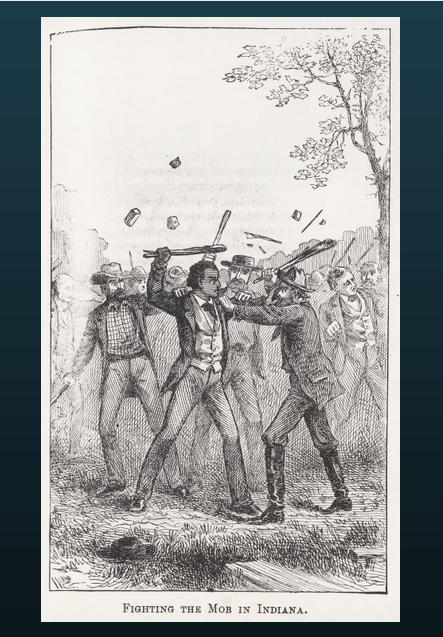
In Douglass’s autobiography, My Life and Times (1881), he used a curious sentence to describe what happened, saying, “They tore down the platform on which we stood, assaulted Mr. White and knocked out several of his teeth, dealt a heavy blow on William A. White, striking him on the back part of the head, badly cutting his scalp and felling him to the ground.” Most historians have assumed that it was William A. White of Massachusetts who received this terrible beating alone. However, it turns out that an overzealous editor simply trimmed someone out of the manuscript.
Other sources supply the name. William A. White himself wrote a description of the event in the October 13, 1843 issue of the newspaper The Liberator. Indiana Quaker abolitionist Levi Coffin mentions it in his Reminiscences published in 1876. Frederick Douglass himself mentions it in an August, 1889 article for Cosmopolitan. After Douglass died in February of 1895, Thomas Lindley of Westfield and J. B. Lewis of Fall Creek Township wrote down their memories of the incident which were published in the local papers. Lindley’s father had been at the meeting and had gotten his hat knocked off. Lewis did not witness the assault, but he was able to see Douglass speak a few nights later at Jonesboro, Indiana. According to all of these people, the injured man was Micajah C. White of Westfield, Indiana. This would explain the odd sentence in the autobiography. Obviously, someone was confused by the two men named White.
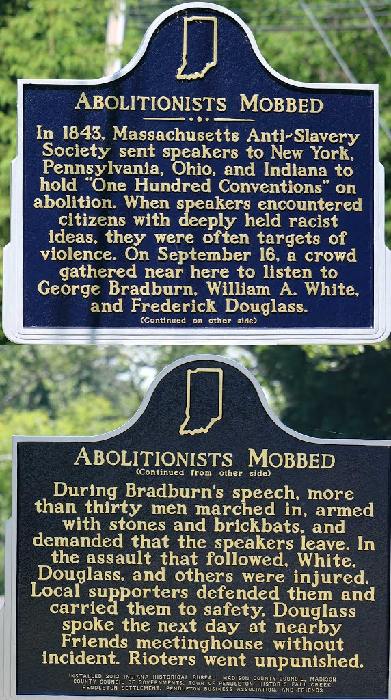
Unfortunately this confusion has obscured Micajah White’s involvement, a man who deserves to be mentioned with the early abolitionists. He was born in New Garden, North Carolina in 1819 to a family of staunch Quakers with strong abolitionist leanings. His father’s sister married Levi Coffin, the famous conductor on the Underground Railroad. The family moved from North Carolina to Milford, Indiana, in 1827, and from there to Hamilton County. In 1833, the Whites were founding members of the Spiceland Quaker Meeting and in 1838, at the age of 19, Micajah was appointed recorder of Meeting Minutes. Sometime in the 1840’s, he married his first wife, Elizabeth. In 1845, his sister Martha began keeping a diary, which presents a clear picture of the family’s fortunes.
Micajah, or “M.C.” as his family called him, joined the newly formed Anti-Slavery Meeting in Eagletown in 1845, two years after the assault. This was a group of dissident Quakers who felt they needed to take a proactive stance on the ending of slavery. These people were the ones most commonly involved in the local Underground Railroad. M.C. was disowned by the Spiceland Meeting for this action.
It seems to be obvious that M.C. would be involved in the Underground Railroad. There is the standard problem that, because it was a secret organization, there is little written evidence of its activities. However, Levi Coffin reported in his Reminiscences that M.C. did assist him.
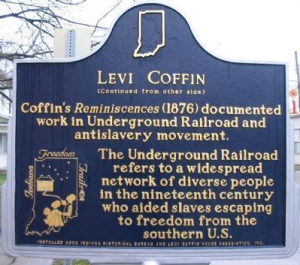
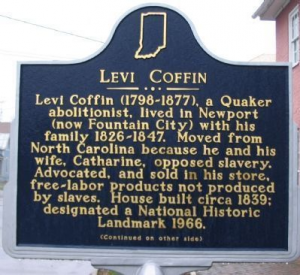
The only local story that survives about M.C.’s activities in the UGRR involves a slave woman who reached Westfield just a step ahead of slave-hunters sometime around 1850. M.C.’s mother, Louisa White, owned an inn and the fugitive was placed in hiding there just as the slave-hunters happened to walk in and asked for food and lodging. Mrs. White calmly served them and then dressed the slave woman in some of her own clothes, including a large bonnet. The two of them coolly walked past the hunters and over to her son M.C.’s house, where the woman was helped on her way.
Of course, there were other concerns in M.C.’s life. His daughter, Madeline, had been born in 1851. His second child, Eugene, was born in January of 1852. Tragically, his wife died in March and his son died in April of that year. He had to balance his own grief with the lives of the people he was assisting.
M.C. was recognized as a key figure in the local anti-slavery movement. His mother’s brother, William Bundun, died in 1855. M.C. and Martha’s husband, Aaron Talbert, were witnesses of his will. After making bequeaths to his wife and children, Bundun said, “I direct also that the sum of 100 dollars when collected by placed in the hands of Micajah C. White or Aaron V. Talbert for the purpose of aiding or assisting destitute fugitive slaves on their way in making their escape from slavery to a land of Liberty – to Canada”. The Talbert and White families were very close. When M.C. remarried in 1856, his new wife was Aaron’s sister, Patience.
Because of their abolitionist sympathies, the Whites were probably more aware of national affairs than most people. The execution of John Brown on Dec. 2 1859, takes up two pages in Martha Talbert’s diary. It was particularly sad for her because it was the same date that her adored infant daughter had died seven years before. M.C. and Aaron Talbert went to the Republican National Convention in Chicago in May of 1860. It is unknown whether they attended as delegates or just spectators. This was, of course, the convention where Abraham Lincoln was nominated to the presidency.
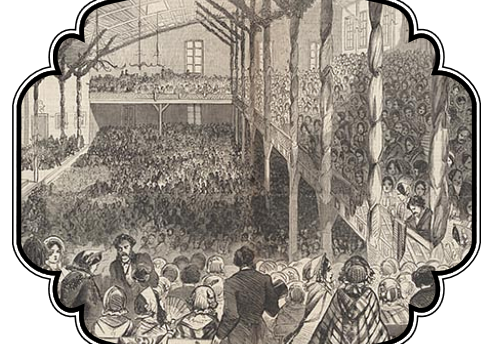
While at the Convention, Underground Railroad activity continued at home and Martha Talbert possibly referenced escaped slaves in her diary. She refers to the people as “Kentucky refugees” and simply states that they are staying there. Any more detail probably would have been dangerous to write down.
When the Civil War started in April of 1861, members of the White family left the Quaker church and joined the Army. M.C.’s brother Isaac joined the 12th Indiana Infantry, a one-year regiment. In 1862, he re-enlisted and joined the 101st Indiana and was appointed a Second Lieutenant. The regiment saw action in Kentucky and Tennessee and Isaac was later promoted to Captain. Another brother, Mordecai, became a recruiter for one of the new black regiments. He traveled to Vicksburg in 1864 to try to enlist ex-slaves. He finally enlisted himself in March of 1865 at about the same time Isaac was discharged for disability.
M.C. probably would have been more proactive at the beginning of the war, but was suffering from a series of lung ailments. In 1862, he became the Military Agent for Washington Township. The job of the Military Agent was to assist the families of soldiers who may have been suffering while the breadwinner was away from home. Then in October of 1863, M.C. decided to move his family to Minneapolis, Minnesota, probably for better economic opportunity. Whatever the reason, he was eventually joined by his sister Martha’s family, his mother, and the rest of his brothers and sisters. They prospered there and M.C. became a druggist. He died at the age of 70 on March 31, 1889, six years before Frederick Douglass.
